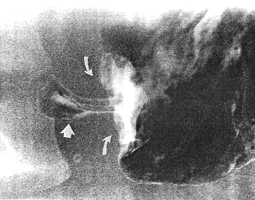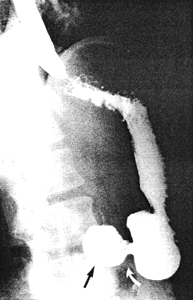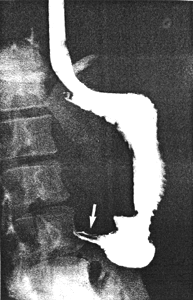


Go to chapter: 1 | 2 | 3 | 4 | 5 | 6 | 7 | 8 | 9 | 10 | 11 | 12 | 13 | 14 | 15 | 16 | 17 | 18 | 19 | 20 | 21 | 22 | 23 | 24 | 25 | 26 | 27 | 28 | 29 | 30 | 31 | 32 | 33 | 34 | 35 | 36 | 37 | 38 | 39
Chapter 26 (page 123)




Go to chapter: 1 | 2 | 3 | 4 | 5 | 6 | 7 | 8 | 9 | 10 | 11 | 12 | 13 | 14 | 15 | 16 | 17 | 18 | 19 | 20 | 21 | 22 | 23 | 24 | 25 | 26 | 27 | 28 | 29 | 30 | 31 | 32 | 33 | 34 | 35 | 36 | 37 | 38 | 39
Chapter 26 (page 123)
 |
Fig. 26.2. Case M.J. Tightly contracted pyloric sphincteric cylinder, containing longitudinal mucosal folds (straight arrow). Retropelled folds bulging into gastric lumen (curved arrows) |
Case 26.3. E.W., female aged 34 years. Having swallowed 4 mouthfuls of barium in the erect position, the patient suddenly started to retch; barium had reached the pyloric aperture but had not traversed it, while some was still in the oesophagus. As soon as retching started a film was exposed. This showed contraction of the left pyloric loop with a "round" collection of barium on its aboral side, i.e. in the sphincteric cylinder (Fig. 26.3A). A segmental or systolic contraction of this collection followed, terminating in a tightly contracted cylinder containing a longitudinal mucosal fold (Fig. 26.3B); this corresponded to maximal contraction of the sphincteric cylinder. During contraction barium contained in the cylinder was propagated not into the duodenum, but in a retrograde way into the more proximal part of the stomach. When retching ceased, normal cyclical contractions of the pyloric sphincteric cylinder and gastric emptying commenced. No organic lesion was found.
A | B |
| Fig. 26.3. A Case E.W. Contraction of left pyloric loop (curved arrow). Round collection of barium in partially contracted sphincteric cylinder (straight arrow). B Case E.W. Maximally contracted sphincteric cylinder containing a longitudinal mucosal fold (arrow). | |
Previous Page | Table of Contents | Next Page
© Copyright PLiG 1998